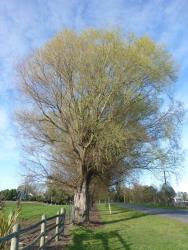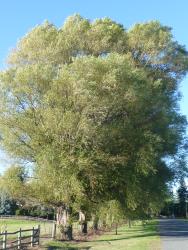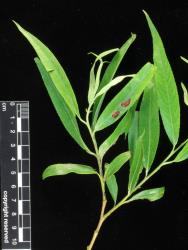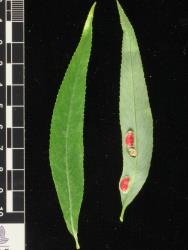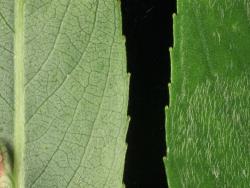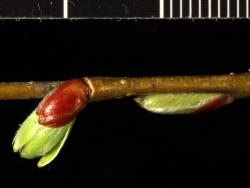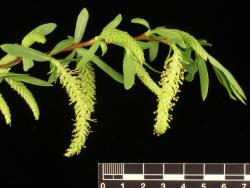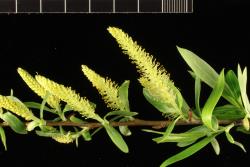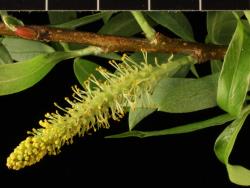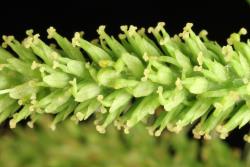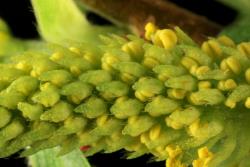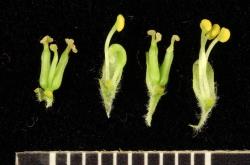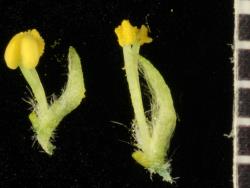Trees 18 m tall, up to 1 m diameter, bark grey, fissured, branchlets somewhat pendulous but branching frequently, terminal branchlets 150–390(–700) mm long. Current year's branchlets with sparse, short-silky hairs. Year-old branchlets glabrous, yellow-green (UCL115) or brown to moderate olive (UCL07), 1.9–2.4 mm diameter. Bud scales 4.5–6.1 mm long, 2.6 mm wide, 1.2–1.6 mm deep, strong red-brown to strong brown (UCL40–55), glabrous or with short-silky hairs, with 2 lateral angles. Stipule somewhat persistent, 10–11 mm long, asymmetrically narrowly ovate. Petiole 4–9 mm long, glabrous or moderately densely tomentose, glands absent, base of petiole pinky red. Emerging leaves green, with densely long-silky hairs below and on margin, upper surface with a few hairs. Proximal leaves entire. Leaf lamina 82–150 mm long, 13–21 mm wide, length to width ratio 6.3–8.2:1, very narrowly elliptical, not falcate; base cuneate; apex very narrowly acute; leaf galls sometimes present, sparse; orange rust in late summer rarely present; margins moderately densely serrulate, flat; upper lamina surface smooth, medium-glossy, glabrous, stomata dense near midvein, sparse elsewhere; lower lamina surface with midvein raised, distinctly glaucous, glabrous. Catkins male, female, or androgynous, emergence coetaneous with leaves or later than leaves. Flowering branch 30–52 mm long with 3–5 leaves. Male catkin 29–50 mm long, 7–10 mm diameter; catkin rachis visible between flowers. Female catkin 20–27 mm long, 3.5–8 mm diameter; catkin rachis not visible between flowers. Flower bract 1.7–3.0 mm long, 0.6–1.0 mm wide, pale yellow or pale green, channelled and curved inwards on long axis; apex acute; hairs varying: dense at base only, dense on margins, or at both base and margins, or sparsely villous all over; female flowering bract persistent. Male nectaries 2, 0.5–0.6 mm long, 0.2–0.3 mm wide, yellow. Stamens 2, filaments usually fused to some degree: at the base, half their length, or almost to the anthers, hairs present at base of filament; anthers 0.56–1.2 mm long, yellow. Female nectary 1, 0.45–0.6 mm long, 0.3–0.60 mm wide, yellow to yellow-green; ovary 1.8–2.5 mm long, glabrous, shorter than the flower bract, sessile; style base 0.3–0.4 mm long, style arms 0.3–0.5 mm long, bilobed about ⅓ of their length, pale yellow.
Salix matsudana × S. alba is early flowering, some clones breaking bud about 8–20 August, slightly before the weeping willow hybrids (Salix ×pendulina) and well before S. ×fragilis. An upright tree form with erect branches, and usually a single straight trunk, giving the tree the erect form of a small poplar. Leaves sometimes have red galls. The lower surface of late season leaves has sparse, long-silky hairs near the midvein, as do all S. alba hybrids. Emerging leaves are green with sparse to moderately densely long-silky hairs on both sides. Branchlets are moderate olive in colour. Catkins of both sexes are 20–50 mm long (longer than for S. ×pendulina, but similar to those of S. ×fragilis). Flower-bud scales are red-brown, which contrasts with the slightly glaucous emerging leaves. A useful feature of male plants is that the stamen filaments are fused to varying degrees in the same catkin, ranging from being fused only at the base to fused half the length of the filament, occasionally nearly the full length of the filament. No other tree willow in New Zealand has this feature, and the variability in the degree of filament fusion is a good indication of a hybrid. A useful feature of female plants is that the style base (below the style arms) is longer than in most other tree willows, 0.2–0.4 mm long (but shared with S. alba), and the style arms are deeply lobed (more so than in S. alba).
Leaf hairs are similar to those of both forms of Salix ×fragilis: in emerging and mature leaves there are long-silky hairs, which vary in density between clones from very sparse to moderately dense. Plants flower well before the two forms of S. ×fragilis. Female plants are unlikely to be S. ×fragilis f. fragilis, which mainly has male plants in New Zealand. Salix matsudana × S. alba has an erect main trunk, while both forms of S. ×fragilis produce large branches from low on the trunk and lack a tall, central trunk, but where trees of S. ×fragilis have been pruned to an upright form, this difference cannot be used. Salix matsudana × S. alba is also similar to the two weeping willows, the forms of S. ×pendulina. It differs most obviously from f. salamonii in lacking golden, strongly pendent terminal branchlets. It is much more difficult to distinguish from S. ×pendulina f. pendulina. They both produce tall, erect trees and both are grown in well-drained soils to provide shade and shelter from wind. Both have short catkins. Male plants cannot be S. ×pendulina f. pendulina as this hybrid is female only. Salix matsudana × S. alba flowers earlier than the two S. ×pendulina hybrids. The main difference between the two is the hanging branchlets and alternating hanging leaves of S. ×pendulina f. pendulina. The leaves of S. ×pendulina f. pendulina often have a yellow-green mottling, which is never present in Salix matsudana × S. alba. It is very difficult to distinguish S. matsudana × S. alba from S. matsudana sensu stricto, particularly since the hybrids with different S. alba parents make the S. matsudana × S. alba hybrid quite variable. Salix matsudana × S. alba is much more common in cultivation than the parent species. There is no difficulty distinguishing S. matsudana × S. alba from S. matsudana 'Tortuosa', with its sinuous branches and twisted concave leaves.
Planted widely throughout New Zealand, especially in shelterbelts on farms.
There are no wild records.
First collection: CHR 472492, W. R. Sykes 186/90, 26 September 1990, Canterbury, Ladbrooks, a shelterbelt tree.
First publication: Hathaway (1986).
Flowering: Early August–mid-October.
Provisionally tetraploid, based on two flow cytometry results using NZ1184 ('Moutere', CHR 644803) and CHR 639171.
This hybrid is widespread in cultivation in New Zealand and appears not to have naturalised. However, in Australia the situation is quite different, as noted by Trounce et al. (2003): "The introduction of New Zealand willows (Salix matsudana hybrids) throughout the Murray-Darling Basin in the 1980s and their widespread sale since then has only just begun to cause problems. These are about to escalate seriously, because the females produce abundant seed and the males fertilise the weeping willow (Salix babylonica), a widespread species that in the past usually did not seed because it had no male partner flowering at the same time."



